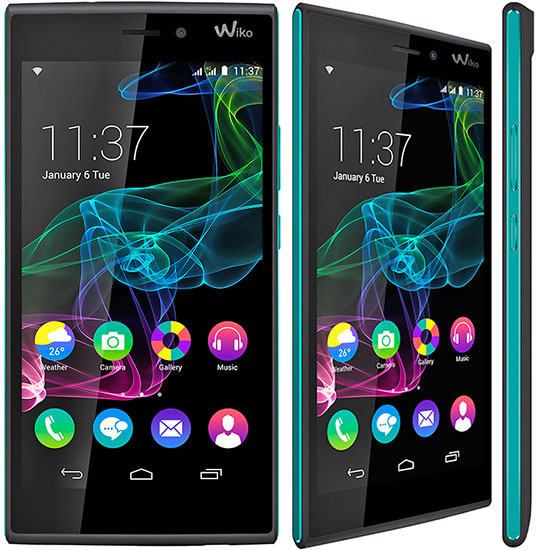
Overview
The Wiko Ridge 4G, launched in early 2015, was a significant addition to the smartphone market with its appealing balance of features and functionality. With a modern design, notable specifications, and competitive pricing, this device reflected Wiko's strategic entry into the highly competitive mid-range smartphone segment. Let’s delve into the detailed aspects of this device.
Design and Build
The Wiko Ridge 4G sports a sleek design marked by its dimensions of 143 x 72 x 7.5 mm and a feather-light weight of 125 g, making it comfortable to hold and use. The phone features a hybrid dual SIM slot which accommodates Nano-SIM and Micro-SIM with dual stand-by, offering flexibility for users requiring two numbers or an additional data card.
Display
The phone boasts a 5.0-inch IPS LCD with a resolution of 720 x 1280 pixels, resulting in a pixel density of approximately 294 ppi. This ensures vibrant colors and sharp visuals, perfect for a satisfying viewing experience. Additionally, the screen is protected by Corning Gorilla Glass 3, enhancing its durability against scratches and everyday wear and tear.
Performance
Under the hood, the Wiko Ridge 4G is powered by a Qualcomm MSM8916 Snapdragon 410 chipset, equipped with a Quad-core 1.2 GHz Cortex-A53 CPU, and an Adreno 306 GPU. These specifications provide a balanced performance ideal for regular smartphone activities such as browsing, media playback, and casual gaming. The device runs on Android 4.4.4 (KitKat), offering a user-friendly interface and compatibility with numerous applications.
Memory and Storage
The device comes with 2GB of RAM and 16GB of internal storage. For users needing more space, it supports microSDXC cards, utilizing the shared SIM slot for memory expansion. This memory capacity is adequate for day-to-day applications and media storage.
Camera
The Wiko Ridge 4G is equipped with a 13 MP autofocus main camera, complemented by features such as LED flash and HDR for improved photo quality in various lighting conditions. It supports video recording at 1080p@30fps, allowing for capturing decent video footage. On the front, the device features a 5 MP selfie camera that records video at 720p@30fps, suitable for video calls and selfies.
Battery Life
The phone uses a non-removable Li-Po 2400 mAh battery. It promises up to 247 hours on standby (2G and 3G) and up to 17 hours of talk time on 2G or 14 hours 40 minutes on 3G, providing sufficient battery life for moderate usage throughout the day.
Connectivity and Network
The Wiko Ridge 4G supports a range of network technologies including GSM, HSPA, and LTE, with compatible bands ensuring wide coverage for mobile connectivity. It offers HSPA speeds of up to 42.2/11.5 Mbps and LTE Cat4 speeds of up to 150/50 Mbps, facilitating smooth browsing and streaming experiences.
Additional Features
For connectivity, the phone includes Wi-Fi 802.11 b/g/n with hotspot capability, Bluetooth 4.0, GPS for navigation, and FM radio. It also features a 3.5mm audio jack for headphones and has a microUSB 2.0 port for charging and data transfer. It is equipped with common sensors like accelerometer, proximity, and compass which enhance the device’s overall functionality.
Color Options and Market Position
The Wiko Ridge 4G was made available in various colors including Black Grey, Black Bleen, Black Clementine, and Arctic Gold, catering to different aesthetic preferences. Although now discontinued, at the time of its release, it offered a competitive package with decent specifications that appealed to users looking for a budget-friendly yet reliable smartphone.
Conclusion
In summary, the Wiko Ridge 4G represented a solid choice for those seeking a well-rounded smartphone without breaking the bank. Its combination of a durable design, reasonable performance, and a user-friendly experience made it a popular choice in its time. As with any tech product, advancements eventually moved the market forward, but the Wiko Ridge 4G remains a testament to Wiko’s ability to deliver value-oriented devices.
Key Features of Wiko Ridge 4G
- Supports GSM / HSPA / LTE technology for fast mobile connectivity.
- Sleek and lightweight design with dimensions of 143 x 72 x 7.5 mm and weight of 125 g.
- Hybrid Dual SIM capability with Nano-SIM and Micro-SIM support.
- 5.0-inch IPS LCD display with HD resolution (720 x 1280 pixels) and Corning Gorilla Glass 3 protection.
- Powered by Qualcomm MSM8916 Snapdragon 410 chipset with a Quad-core 1.2 GHz Cortex-A53 CPU and Adreno 306 GPU.
- Comes with 16GB internal storage and 2GB RAM; expandable via microSDXC using the shared SIM slot.
- 13 MP main camera with autofocus and LED flash, capable of 1080p video recording.
- 5 MP front-facing camera, supports 720p video recording.
- Loudspeaker and 3.5mm headphone jack for audio output.
- Connectivity options include Wi-Fi 802.11 b/g/n, Bluetooth 4.0, GPS, and FM radio.
- Includes sensors like accelerometer, proximity, and compass for enhanced usability.
- Equipped with a non-removable Li-Po 2400 mAh battery providing up to 17 hours of talk time on 2G networks.
- Available in four color variants: Black Grey, Black Bleen, Black Clementine, and Arctic Gold.
Disadvantages of Wiko Ridge 4G
- Outdated Operating System: Comes with Android 4.4.4 (KitKat), which is outdated and may not support newer applications.
- Limited Internal Storage: Only 16GB internal storage which might not be sufficient for heavy users without frequent data management.
- Shared SIM Slot: Uses a hybrid dual SIM slot, meaning users have to choose between a second SIM and a microSD card for expanded storage.
- No NFC Support: Lacks Near Field Communication (NFC) capability, limiting options for contactless payments.
- Non-Removable Battery: The Li-Po 2400 mAh battery is non-removable, making replacements or resets difficult.
- Discontinued Status: The phone has been discontinued, which might affect the availability of spare parts or repair services.
- Moderate Display Resolution: Resolution of 720 x 1280 pixels might not be as sharp as newer smartphone displays.
- Lacks Advanced Sensors: Does not include advanced sensors like a fingerprint sensor.

View Also
More Phones
All Rights Reserved +14038 Phones © Mobilawy 2025

























